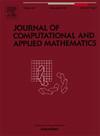基于统计检验的常参数和随机参数异常扩散模型判别框架
IF 2.6
2区 数学
Q1 MATHEMATICS, APPLIED
Journal of Computational and Applied Mathematics
Pub Date : 2025-06-05
DOI:10.1016/j.cam.2025.116801
引用次数: 0
摘要
反常扩散描述了均方位移随时间非线性缩放的过程,E(X2(t)) ~ tβ,其中β称为反常指数。这种行为,在生物细胞等复杂系统中可以看到,经常违背标准的扩散模型。分数布朗运动(FBM)和比例布朗运动(SBM)等经典模型假设指数恒定,无法捕捉到具有不同异常参数的动力学。为了解决这一局限性,引入了随机指数FBM (FBMRE)和随机指数SBMRE等模型。这项工作提出了一个基于统计测试框架的通用程序,该框架使用时间平均统计数据和基于比率的对应数据区分具有恒定和随机异常指数的异常扩散模型。提出了一种通过散度度量(这里是海灵格距离)优化时滞选择的新方法。所介绍的方法广泛适用于恒定与随机异常扩散场景,其有效性取决于统计选择、时间滞后和过程特性,如模拟(异常指数的两点分布)和实际数据分析所示。本文章由计算机程序翻译,如有差异,请以英文原文为准。
Statistical testing-based framework for differentiating anomalous diffusion models with constant and random parameters
Anomalous diffusion describes processes where the mean squared displacement scales non-linearly with time, , where is termed the anomalous exponent. This behavior, seen in complex systems like biological cells, often defies standard diffusion models. Classical models such as fractional Brownian motion (FBM) and scaled Brownian motion (SBM) assume constant exponents, failing to capture dynamics with varying anomalous parameters. To address this limitations, models like FBM with random exponents (FBMRE) and SBM with random exponents (SBMRE) were introduced. This work proposes an universal procedure based on statistical testing framework that distinguishes between anomalous diffusion models with constant and random anomalous exponents using time-averaged statistics and their ratio-based counterparts. A novel procedure for optimizing time lag selection via divergence measure (here the Hellinger distance) is also proposed. The introduced methodology applies broadly to constant vs. random anomalous diffusion scenarios, with effectiveness depending on statistic selection, time lags, and process properties, as shown in simulations (with the two-point distribution of anomalous exponent) and real-world data analysis.
求助全文
通过发布文献求助,成功后即可免费获取论文全文。
去求助
来源期刊
CiteScore
5.40
自引率
4.20%
发文量
437
审稿时长
3.0 months
期刊介绍:
The Journal of Computational and Applied Mathematics publishes original papers of high scientific value in all areas of computational and applied mathematics. The main interest of the Journal is in papers that describe and analyze new computational techniques for solving scientific or engineering problems. Also the improved analysis, including the effectiveness and applicability, of existing methods and algorithms is of importance. The computational efficiency (e.g. the convergence, stability, accuracy, ...) should be proved and illustrated by nontrivial numerical examples. Papers describing only variants of existing methods, without adding significant new computational properties are not of interest.
The audience consists of: applied mathematicians, numerical analysts, computational scientists and engineers.

 求助内容:
求助内容: 应助结果提醒方式:
应助结果提醒方式:


